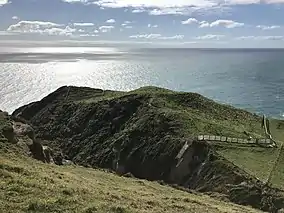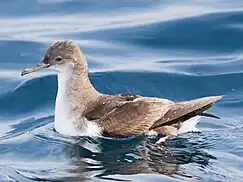| Wharariki Ecosanctuary | |
|---|---|
 | |
| Nearest city | Collingwood |
| Coordinates | 40°29′57″S 172°41′44″E / 40.4992°S 172.6956°E |
| Area | 2.5 ha (6.2 acres) |
| Established | January 2020 |
| Operator | Farewell Wharariki HealthPost Nature Trust |
Wharariki Ecosanctuary is a wildlife sanctuary within a predator-proof fence at Cape Farewell, New Zealand.
Location
The Wharariki Ecosanctuary is located on a headland on the Wharariki coastline at Cape Farewell. It is sited on conservation land that is managed as the Puponga Farm Park.[1][2]
Establishment
The project was initiated by Peter Butler, who created a trust in 2017 to protect local wildlife in the region from Wharariki Beach to the tip of Farewell Spit.[3] The Farewell Wharariki HealthPost Nature Trust was registered as a Charitable Trust in May 2021.[4]
The sanctuary has been created in a collaboration between the Collingwood-based HealthPost Nature Trust, the Department of Conservation and Manawhenua ki Mōhua, representing Ngāti Tama, Te Ātiawa and Ngāti Rārua in the Golden Bay/ Mohua area. Starting in September 2019, a 200 metres (660 ft) predator-proof fence was constructed above the cliffs at Wharariki, enclosing 2.5 ha (6.2 acres).[5] The fence was completed in January 2020,[6] and the sanctuary was officially opened by Eugene Sage (Minister of Conservation), along with local iwi, and the sanctuary patron, broadcaster Kim Hill.[7]
Prior to the translocation of burrow-nesting seabirds, the area was prepared by building artificial burrows, trapping pests and planting around the site.[8]
In the Sustainable Business Awards 2021, HealthPost received a commendation in the Restoring Nature Award category, for their work in developing the ecosanctuary.[9]
Revegetation
By 2021, around 3000 trees had been planted in the sanctuary and around the Wharariki wetland. Species planted include kanuka, kaikomako and ti kouka (cabbage tree).[10]
Translocation of fluttering shearwaters

In January 2022, 50 fluttering shearwater (Puffinus gavia) or pakahā chicks were translocated from the Long Island – Kokomohua Marine Reserve in Queen Charlotte Sound to the Wharariki Ecosanctuary.[11][8] They were the first species to be introduced to the fenced sanctuary.[12]
In January 2023, another 56 fluttering shearwater chicks were translocated from the Long Island – Kokomohua Marine Reserve to the Wharariki Ecosanctuary. They were transferred due to weather events impacting their burrows on Long Island. It is hoped they will establish a breeding colony.[13] One of the group of volunteers assisting with the relocation was teenage environmentalist Nate Wilbourne.[14]
A third translocation of chicks to the sanctuary was undertaken in January 2024.[15]
References
- ↑ "Farewell Wharariki Eco Sanctuary". Lone Star Farms. Archived from the original on 23 May 2022. Retrieved 18 April 2022.
- ↑ "Farewell Spit and Puponga Farm Park". Department of Conservation. Archived from the original on 29 May 2022. Retrieved 18 April 2022.
- ↑ "Peter Butler: Building a predator-free sanctuary". RNZ. 14 December 2019. Archived from the original on 23 January 2022. Retrieved 18 April 2022.
- ↑ "Farewell Wharariki HealthPost Nature Trust". NZBN. Archived from the original on 17 April 2022. Retrieved 18 April 2022.
- ↑ Gee, Samantha (20 September 2019). "New sanctuary to boost seabird numbers at Cape Farewell". Stuff. Archived from the original on 5 April 2023. Retrieved 23 June 2023.
- ↑ "Predator-free sanctuary for seabirds, rare native plants opens at Cape Farewell". RNZ. 18 January 2020. Archived from the original on 29 January 2022. Retrieved 18 April 2022.
- ↑ O'Connell, Tim (19 January 2020). "Conservation minister opens new Golden Bay ecosanctuary at Cape Farewell". Stuff. Archived from the original on 5 April 2023. Retrieved 23 June 2023.
- 1 2 Sivignon, Cherie (20 January 2022). "First fluttering shearwater chicks arrive at Cape Farewell sanctuary". Stuff. Archived from the original on 26 January 2022. Retrieved 26 January 2022.
- ↑ "2021 Restoring Nature Award". Sustainable Business Network. Archived from the original on 28 May 2022. Retrieved 21 April 2022.
- ↑ "Cape Farewell ecosanctuary progressing despite setbacks". New Zealand Geographic. Retrieved 23 June 2023.
- ↑ Hindmarsh, Gerard (27 November 2021). "Once hunted but 'Flocks of gods' now venerated at Farewell Spit". Nelson Mail. Archived from the original on 21 April 2022. Retrieved 21 April 2022 – via Stuff.
- ↑ Gee, Samantha (23 January 2022). "Hope seabirds establish new colony at Cape Farewell Sanctuary". RNZ. Archived from the original on 17 February 2022. Retrieved 18 April 2022.
- ↑ Hart, Maia (24 January 2023). "Second round of fluttering shearwater introduced to Cape Farewell from Marlborough Sounds". RNZ. Archived from the original on 25 January 2023. Retrieved 25 January 2023.
- ↑ "Volunteers to release 100 pakahā chicks at Cape Farewell ecosanctuary". RNZ. 21 January 2023. Archived from the original on 9 June 2023. Retrieved 23 June 2023.
- ↑ Jones, Katy (12 January 2024). "Third round of seabird chicks headed for Cape Farewell in restoration effort". The Press. Retrieved 14 January 2024.